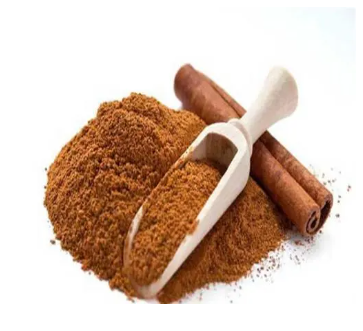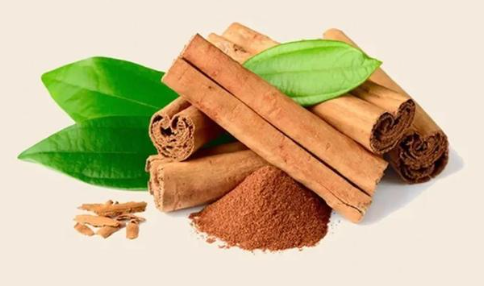Cinnamaldehyde, also known as cinnamaldehyde, cinnamaldehyde β - Benacrolein or 3-phenyl-2acrolein is an aldehyde organic compound found in essential oils such as cinnamon oil, rose oil, and patchouli oil. Its chemical name is triphenylacrolein, with the molecular formula C9H8O. Under normal pressure, it has a melting point of -8 ℃ and a boiling point of 253 ℃, and exists in liquid form. Cinnamaldehyde has two isomers, cis and trans, and natural cinnamaldehyde has a trans structure. Cinnamaldehyde has a strong and long-lasting fragrance of cinnamon oil, with characteristics such as antibacterial and anti mold properties, vasodilation and blood pressure lowering. It is widely used in fields such as medicine and food industry.

01
The physiological functions of cinnamaldehyde
Cinnamaldehyde has the effect of reducing blood sugar and blood fat, and can be used to treat type II diabetes. Cinnamaldehyde intake can improve the utilization rate of glucose and esters, so as to reduce blood sugar and blood fat. The study showed that the fasting blood glucose, triglyceride and low-density lipoprotein content of type II diabetes patients were significantly reduced after taking cinnamaldehyde. Cinnamaldehyde can be used for the treatment of anti cellular fibrosis. Studies have shown that cinnamaldehyde can inhibit the proliferation and hypertrophy of renal interstitial fibroblasts caused by high glucose, as well as the synthesis and secretion of interstitial collagen. Huang Jiangyan studied high sugar induced rats and found that cinnamaldehyde can reduce the proliferation of rat myocardial fibroblasts, inhibit the synthesis and secretion of interstitial collagen. Cai Leiqin et al. showed that cinnamaldehyde can specifically activate the nuclear factor E-2 related factor pathway and promote wound healing in diabetes mice. Some studies have shown that cinnamaldehyde can resist gastrointestinal ulcers by inhibiting the erosion of gastric mucosa by pepsin and increasing the blood flow rate of gastric mucosa; It can gently stimulate the gastrointestinal tract, promote the secretion of saliva and gastric juice, enhance digestive function, promote appetite, relieve gastrointestinal smooth muscle spasms, and alleviate intestinal spasmodic pain.

02
The antibacterial effect of cinnamaldehyde
Cinnamaldehyde has a broad-spectrum antibacterial effect. Zhang Wenjuan et al. conducted cinnamaldehyde antifungal experiments on 22 species and 31 strains of conditionally pathogenic fungi, and the results showed that cinnamaldehyde has good inhibitory effects on fungi such as Aspergillus flavus, Aspergillus fumigatus, and Penicillium citri. Cinnamaldehyde can increase the content of reactive oxygen species in certain bacteria, causing oxidative damage and leading to their death. Wang Fan et al. applied cinnamaldehyde to Escherichia coli and Pseudomonas aeruginosa and found that after treatment with cinnamaldehyde solution, the growth of Escherichia coli was inhibited, and the content of hydrogen peroxide, malondialdehyde, and other substances in the bacterial body significantly increased. There was a biofilm on the surface of Pseudomonas aeruginosa cells, and although the accumulation of reactive oxygen species was not detected in their bodies, their growth metabolism was also affected. Cinnamaldehyde can inhibit bacterial growth by disrupting bacterial structure and normal metabolic function. Cinnamaldehyde contains aldehyde groups, which have a certain hydrophilicity and are easily adsorbed on the hydrophilic groups on the surface of fungi. It has a certain inhibitory effect on the activities of chitin synthase and glucan synthase on the cell membrane, thereby inhibiting the generation of chitin and glucose in the cell wall, damaging the polysaccharide structure of the cell wall, and inhibiting bacterial growth; It can also dissolve between adjacent acyl chains in the hydrophobic waters of the cell membrane, enhancing the permeability of the cell membrane, leading to ATP leakage and bacterial death. Cinnamaldehyde can inhibit bacterial growth by affecting the normal expression of DNA or RNA within cells. Xie Xiaomei and others used laser scanning confocal microscopy to observe and analyze DNA and RNA in Aspergillus flavus and Aspergillus fumigatus. They found that cinnamaldehyde can interfere with DNA synthesis and normal RNA metabolism, leading to abnormal protein metabolism, inability to complete the normal cell cycle, and inhibition of mold growth. Cinnamaldehyde can inhibit the expression of the key gene FKS, leading to inhibition of the synthesis of polysaccharides in the cell wall of Aspergillus fumigatus, thereby inhibiting the growth of the mold. Cinnamaldehyde can inhibit the growth of bacterial cells by blocking their metabolism. Dai Xiangrong et al. analyzed the changes in optical density and malondialdehyde value of Aspergillus flavus spore extract under different inhibition methods and found that cinnamaldehyde can block metabolic pathways during growth by inhibiting the activity of certain enzymes in cells, ultimately leading to the inability of spores to germinate normally and grow into colonies. The functional group aldehyde group of cinnamaldehyde can react chemically with functional groups of proteins in cells, such as amino and carboxyl groups, thereby inhibiting enzyme activity and even causing enzyme inactivation.

03
Metabolism of cinnamaldehyde
Su Shuang conducted animal experiments with cinnamon oil and found that cinnamaldehyde can be rapidly metabolized into cinnamic acid in rats. Sapienza P et al.'s experiment showed that high doses of labeled cinnamaldehyde taken can be excreted in the form of metabolites through urine, with a few excreted in feces, with benzoic acid being the main metabolite. There are multiple metabolic pathways for cinnamaldehyde, which can be oxidized to cinnamic acid by NAD dependent aldehyde dehydrogenase and excreted by binding to other salts; It can also be further β - oxidized or react with reducing glutathione to form thioetheramine derivatives, which then combine with other compounds and are ultimately eliminated from the body, leaving very little residue in the human body. 04
The application of cinnamaldehyde in food
Due to its excellent antibacterial properties, cinnamaldehyde is widely used in food preservation. The main methods of use are: fumigation, film preparation, lotion treatment. After fumigating the experimental group of shiitake mushrooms with cinnamaldehyde, Wen Xiaoli et al. found that compared to the control group, the experimental group had a decrease in microbial content, slow respiration, reduced oxidative damage, and a slower decrease in water content. All indicators show that cinnamaldehyde fumigation treatment can effectively maintain the quality of shiitake mushrooms and have a good preservation effect. Wang Liqiang and others used cinnamaldehyde and calcium propionate as antibacterial agents, combined with substances such as potato starch, glycerol, and calcium chloride to prepare antibacterial edible films. These films can effectively inhibit the growth and reproduction of microorganisms in chilled meat, slow down water loss, and have a good preservation effect on chilled meat. Wang Qingkui et al. prepared cinnamaldehyde nanoemulsion using cinnamaldehyde, Tween 80, ethanol, ethyl acetate, and distilled water. Antibacterial experiments were conducted on four common pathogenic bacteria in aquatic animals using cinnamaldehyde nanoemulsion and the same concentration of cinnamaldehyde solution. The results showed that cinnamaldehyde nanoemulsion had a better effect. Li Hongliang et al. conducted research using cinnamaldehyde as a food preservative and found that, on the basis of reducing the dosage of traditional preservatives, the compound preservative of cinnamaldehyde has better anti-corrosion and fresh-keeping effects. Cinnamaldehyde has a strong and long-lasting special aroma of cinnamon oil, and is commonly used in food additives. Adding trace amounts of cinnamon oil to Chinese soup, coffee, cookies, and baked goods can enhance the flavor of the food. Adding cinnamaldehyde to chewing gum can enhance its aroma, mask bad breath, and eliminate some oral bacteria.

05
expectation
Cinnamaldehyde, due to its excellent broad-spectrum antibacterial properties and unique aromatic aroma, plays a dual role in the food industry in terms of preservation, preservation, and improvement of flavor and taste. Cinnamaldehyde is metabolized quickly and has minimal residue in the human body. It is recognized as a safe and non-toxic food flavoring by the Association of Flavor and Extract Manufacturers (FEMA) in the United States, and is also recognized by the Food and Drug Administration (FDA) as a safe and non-toxic substance. In China, cinnamaldehyde is also recognized as a synthetic spice for food, which can be used in meat, candy, chewing gum, seasoning, etc. However, cinnamaldehyde has poor water solubility, strong volatility, and strong aroma, which can easily affect the original flavor of food, thus limiting its application in food preservation and preservation. Some derivatives of cinnamaldehyde have similar properties to cinnamaldehyde, such as cinnamic acid, which has a lighter cinnamic aroma and antibacterial properties; Studies have shown that cinnamaldehyde microemulsions can solve the problem of poor water solubility and have good antibacterial effects. Further research and development of derivatives of cinnamaldehyde and related products such as microemulsions can better expand the application scope of cinnamaldehyde.
Shaanxi Huike Botanical Development Co., Ltd. a integrated enterprise which is focus on natural products, Plant extract related products and services.We mainly focus on pharmaceutical, functional food, Freeze-dried powder,Natural Pigment,Homology of medicine and food,beverages and other business services.
For more information about inulin, please contact us!
Email:marketing@huikes.com
2024-05-29
Shaanxi Huike Botanical Development Co., Ltd.






